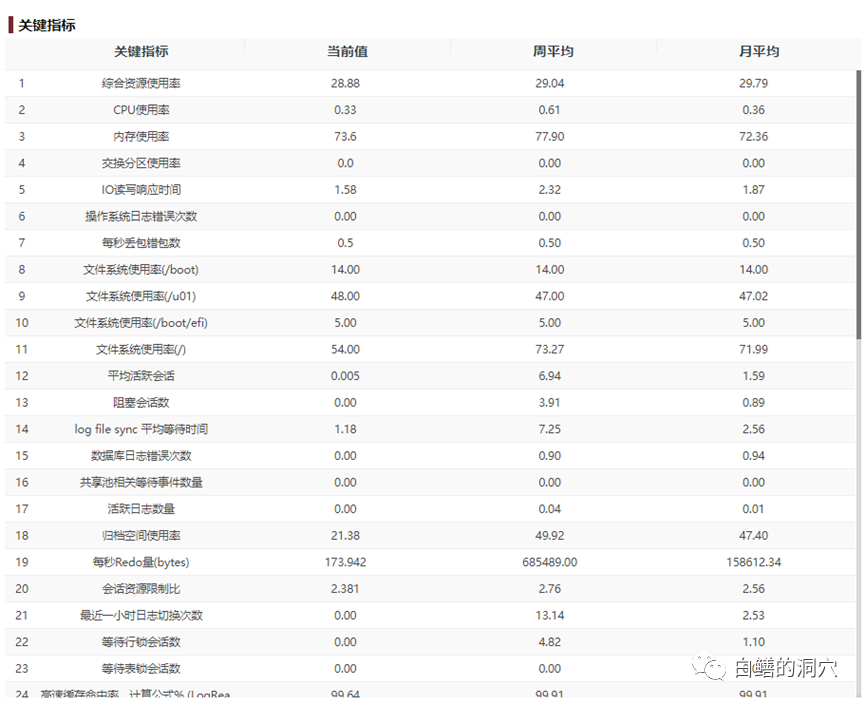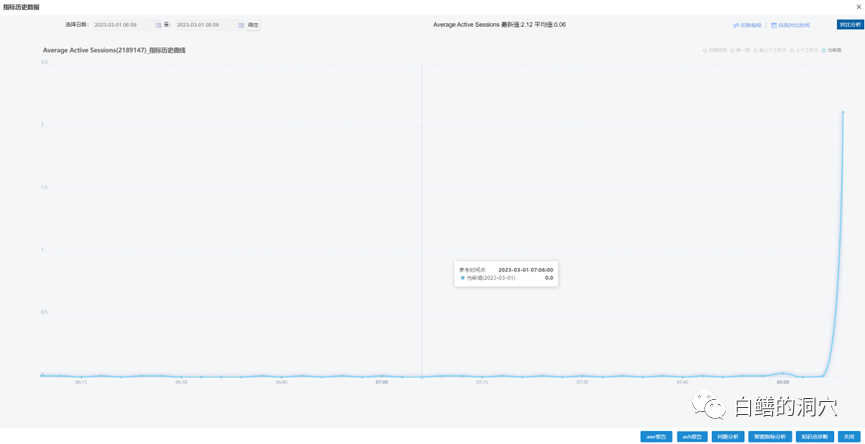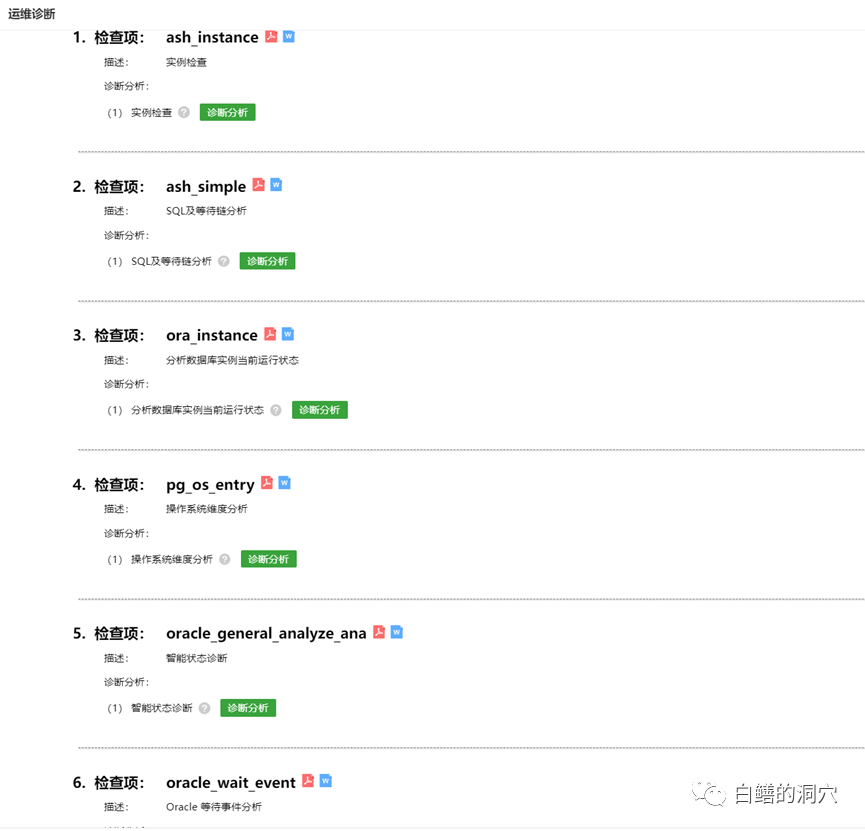From monitoring to diagnostics: the power of data
Monitoring and diagnosis have always been two very important links in database operation and maintenance. In the traditional operation and maintenance model, monitoring and diagnosis are people-centered, so the collection of indicators and data must also focus on people. Expand.

Monitoring data needs to be viewed by people. Through human viewing, we can find abnormalities or areas worthy of vigilance in the monitoring data. DBAs of different levels can see different levels of risk from the data. Because it requires people to see it, there should not be too many indicators displayed, otherwise the monitoring personnel will be dazzled. In fact, the number of key indicators in the above picture is too many to monitor.

For monitoring that relies on people, a brief and intuitive indicator display is very necessary. For databases, only focusing on three or five key indicators can better achieve manual monitoring. One of my financial clients only pays attention to the active membership indicator for the core system. There is a monitor who keeps an eye on this indicator at any time. Once an abnormality occurs, he clicks on the relevant indicator for diagnostic analysis.

This is an indicator historical data monitoring page modified according to their needs. Once the number of active sessions indicator exceeds the standard, click to diagnose. On this page we provide a "Problem Analysis" tool.

The problem analysis tool can analyze the problems existing in the system (current problems or historical problems) according to the time window, while the waiting event analysis tool can analyze the problems from The perspective of waiting events helps DBA analyze possible performance problems in the system.
No matter what, the purpose of monitoring is to make the DBA's work easier, to serve people, and to be people-centered. Some friends may not agree with this and think that monitoring can also be automated, such as baseline alarms. In fact, the baseline alarm is similar. For example, the baseline alarm can tell you through SMS that the number of active sessions is abnormal. However, if the baseline alarm template sets too many indicators, the processing of alarm storms will be very troublesome. Inaccurate alarms will make the alarm function seem useless.
Traditional diagnosis is also people-centered. When there is a problem with the system, various information is searched for and analyzed in the system. This analysis relies heavily on the DBA's personal abilities. When a big problem occurs to users, they always hope that high-level experts can come to the scene to deal with it as soon as possible.
With the development of enterprise digitization, the cost of this human-centered monitoring and diagnosis model is getting higher and higher, and experts are less willing to sit on the front line. Therefore, saving labor costs and saving experts' time has become a very important requirement in database operation and maintenance. In fact, with the development of hardware, the costs of data collection, storage and calculation have become very low. Therefore, in modern database monitoring systems, it is no longer cost-prohibitive to collect and save more complete monitoring data.
If the data collected daily is rich enough, automated diagnosis and remote diagnosis will become possible. The data required for diagnostic work is already in the offline collected database. Most diagnostic tools no longer need to temporarily collect data from the database instance. Then when an abnormality occurs in the database, the automatic diagnostic tool can be used in the background without risk. Perform automated analysis.
The no risk mentioned here means that the automated diagnosis work itself will not bring any risk to the database instance. If it is necessary to temporarily collect some data from the database during automated diagnosis, then if this collection itself is risky, then it may be a move to add insult to injury on a database instance that is already faulty. We once made a tool for automatic diagnosis and analysis of shared pool fragmentation, which needed to analyze KGH data. This tool once brought down the database. Therefore, in terms of automated indicator collection and automated diagnosis, we will try our best to avoid the occurrence of such risks.
To achieve all this, the most important power behind it is data. Data is the first basis for monitoring and diagnosis automation. In fact, in automated database operation and maintenance, the indicator set and data collection itself contain rich operation and maintenance knowledge. Which indicators should be collected by a certain database and how to better collect database indicators without risk is very valuable operation and maintenance knowledge.
This year, we will open source the indicator sets of Oracle, Mysql, Postgresql, Dameng, Jincang and other databases in D-SMART. We also hope that everyone can join us to enrich and improve them together. This open source indicator set.
The above is the detailed content of From monitoring to diagnostics: the power of data. For more information, please follow other related articles on the PHP Chinese website!

Hot AI Tools

Undresser.AI Undress
AI-powered app for creating realistic nude photos

AI Clothes Remover
Online AI tool for removing clothes from photos.

Undress AI Tool
Undress images for free

Clothoff.io
AI clothes remover

Video Face Swap
Swap faces in any video effortlessly with our completely free AI face swap tool!

Hot Article

Hot Tools

Notepad++7.3.1
Easy-to-use and free code editor

SublimeText3 Chinese version
Chinese version, very easy to use

Zend Studio 13.0.1
Powerful PHP integrated development environment

Dreamweaver CS6
Visual web development tools

SublimeText3 Mac version
God-level code editing software (SublimeText3)

Hot Topics
 1389
1389
 52
52
 Use ddrescue to recover data on Linux
Mar 20, 2024 pm 01:37 PM
Use ddrescue to recover data on Linux
Mar 20, 2024 pm 01:37 PM
DDREASE is a tool for recovering data from file or block devices such as hard drives, SSDs, RAM disks, CDs, DVDs and USB storage devices. It copies data from one block device to another, leaving corrupted data blocks behind and moving only good data blocks. ddreasue is a powerful recovery tool that is fully automated as it does not require any interference during recovery operations. Additionally, thanks to the ddasue map file, it can be stopped and resumed at any time. Other key features of DDREASE are as follows: It does not overwrite recovered data but fills the gaps in case of iterative recovery. However, it can be truncated if the tool is instructed to do so explicitly. Recover data from multiple files or blocks to a single
 Open source! Beyond ZoeDepth! DepthFM: Fast and accurate monocular depth estimation!
Apr 03, 2024 pm 12:04 PM
Open source! Beyond ZoeDepth! DepthFM: Fast and accurate monocular depth estimation!
Apr 03, 2024 pm 12:04 PM
0.What does this article do? We propose DepthFM: a versatile and fast state-of-the-art generative monocular depth estimation model. In addition to traditional depth estimation tasks, DepthFM also demonstrates state-of-the-art capabilities in downstream tasks such as depth inpainting. DepthFM is efficient and can synthesize depth maps within a few inference steps. Let’s read about this work together ~ 1. Paper information title: DepthFM: FastMonocularDepthEstimationwithFlowMatching Author: MingGui, JohannesS.Fischer, UlrichPrestel, PingchuanMa, Dmytr
 Comprehensive Guide to PHP 500 Errors: Causes, Diagnosis and Fixes
Mar 22, 2024 pm 12:45 PM
Comprehensive Guide to PHP 500 Errors: Causes, Diagnosis and Fixes
Mar 22, 2024 pm 12:45 PM
A Comprehensive Guide to PHP 500 Errors: Causes, Diagnosis, and Fixes During PHP development, we often encounter errors with HTTP status code 500. This error is usually called "500InternalServerError", which means that some unknown errors occurred while processing the request on the server side. In this article, we will explore the common causes of PHP500 errors, how to diagnose them, and how to fix them, and provide specific code examples for reference. Common causes of 1.500 errors 1.
 Google is ecstatic: JAX performance surpasses Pytorch and TensorFlow! It may become the fastest choice for GPU inference training
Apr 01, 2024 pm 07:46 PM
Google is ecstatic: JAX performance surpasses Pytorch and TensorFlow! It may become the fastest choice for GPU inference training
Apr 01, 2024 pm 07:46 PM
The performance of JAX, promoted by Google, has surpassed that of Pytorch and TensorFlow in recent benchmark tests, ranking first in 7 indicators. And the test was not done on the TPU with the best JAX performance. Although among developers, Pytorch is still more popular than Tensorflow. But in the future, perhaps more large models will be trained and run based on the JAX platform. Models Recently, the Keras team benchmarked three backends (TensorFlow, JAX, PyTorch) with the native PyTorch implementation and Keras2 with TensorFlow. First, they select a set of mainstream
 Slow Cellular Data Internet Speeds on iPhone: Fixes
May 03, 2024 pm 09:01 PM
Slow Cellular Data Internet Speeds on iPhone: Fixes
May 03, 2024 pm 09:01 PM
Facing lag, slow mobile data connection on iPhone? Typically, the strength of cellular internet on your phone depends on several factors such as region, cellular network type, roaming type, etc. There are some things you can do to get a faster, more reliable cellular Internet connection. Fix 1 – Force Restart iPhone Sometimes, force restarting your device just resets a lot of things, including the cellular connection. Step 1 – Just press the volume up key once and release. Next, press the Volume Down key and release it again. Step 2 – The next part of the process is to hold the button on the right side. Let the iPhone finish restarting. Enable cellular data and check network speed. Check again Fix 2 – Change data mode While 5G offers better network speeds, it works better when the signal is weaker
 The vitality of super intelligence awakens! But with the arrival of self-updating AI, mothers no longer have to worry about data bottlenecks
Apr 29, 2024 pm 06:55 PM
The vitality of super intelligence awakens! But with the arrival of self-updating AI, mothers no longer have to worry about data bottlenecks
Apr 29, 2024 pm 06:55 PM
I cry to death. The world is madly building big models. The data on the Internet is not enough. It is not enough at all. The training model looks like "The Hunger Games", and AI researchers around the world are worrying about how to feed these data voracious eaters. This problem is particularly prominent in multi-modal tasks. At a time when nothing could be done, a start-up team from the Department of Renmin University of China used its own new model to become the first in China to make "model-generated data feed itself" a reality. Moreover, it is a two-pronged approach on the understanding side and the generation side. Both sides can generate high-quality, multi-modal new data and provide data feedback to the model itself. What is a model? Awaker 1.0, a large multi-modal model that just appeared on the Zhongguancun Forum. Who is the team? Sophon engine. Founded by Gao Yizhao, a doctoral student at Renmin University’s Hillhouse School of Artificial Intelligence.
 Tesla robots work in factories, Musk: The degree of freedom of hands will reach 22 this year!
May 06, 2024 pm 04:13 PM
Tesla robots work in factories, Musk: The degree of freedom of hands will reach 22 this year!
May 06, 2024 pm 04:13 PM
The latest video of Tesla's robot Optimus is released, and it can already work in the factory. At normal speed, it sorts batteries (Tesla's 4680 batteries) like this: The official also released what it looks like at 20x speed - on a small "workstation", picking and picking and picking: This time it is released One of the highlights of the video is that Optimus completes this work in the factory, completely autonomously, without human intervention throughout the process. And from the perspective of Optimus, it can also pick up and place the crooked battery, focusing on automatic error correction: Regarding Optimus's hand, NVIDIA scientist Jim Fan gave a high evaluation: Optimus's hand is the world's five-fingered robot. One of the most dexterous. Its hands are not only tactile
 The first robot to autonomously complete human tasks appears, with five fingers that are flexible and fast, and large models support virtual space training
Mar 11, 2024 pm 12:10 PM
The first robot to autonomously complete human tasks appears, with five fingers that are flexible and fast, and large models support virtual space training
Mar 11, 2024 pm 12:10 PM
This week, FigureAI, a robotics company invested by OpenAI, Microsoft, Bezos, and Nvidia, announced that it has received nearly $700 million in financing and plans to develop a humanoid robot that can walk independently within the next year. And Tesla’s Optimus Prime has repeatedly received good news. No one doubts that this year will be the year when humanoid robots explode. SanctuaryAI, a Canadian-based robotics company, recently released a new humanoid robot, Phoenix. Officials claim that it can complete many tasks autonomously at the same speed as humans. Pheonix, the world's first robot that can autonomously complete tasks at human speeds, can gently grab, move and elegantly place each object to its left and right sides. It can autonomously identify objects




